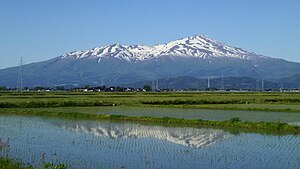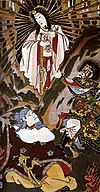Toyouke-hime
This article may be a rough translation from Japanese. It may have been generated, in whole or in part, by a computer or by a translator without dual proficiency. (September 2024) |
| Toyouke-hime | |
|---|---|
| Other names | Luxuriant food princess |
| Major cult centre | Chōkaisan Ōmonoimi Shrine Toyouke Daijingu |
Toyouke-hime is the goddess of agriculture, industry, food,[1] clothing,[1] and houses[1] in the Shinto religion. Originally enshrined in the Tanba region[a] of Japan, she was called to reside at Gekū, Ise Shrine, about 1,500 years ago at the age of Emperor Yūryaku to offer sacred food to Amaterasu Ōmikami, the Sun Goddess.[2]

While popular as Toyouke-Ōhmikami presently,[3] her name has been transcribed using Chinese characters in several manners including Toyouke bime no kami (
Several alternative transcription and names are attributed to this goddess including Toyouke-Okami,[1] Toyouke-Ōmikami, Toyoukebime no kami (
There is a separate shrine dedicated to Toyouke's Ara-mitama, or Toyouke-Ōmikami no Ara-mitama (
Mythology
[edit]In Kojiki, Toyouke-Ōmikami is described as the granddaughter to Izanami via her father Wakumusubi, and Toyouke was said to settle to Gekū, Ise Shrine at Watarai (
The head priest of Toyouke Daijingu submitted "Toyuke Shrine Book of Rituals (
Stories among various Fudoki indicate the origin of Toyouke: In that of Tango, or "Tango no kuni fudoki", Toyouke-bime (
Faith and rituals
[edit]She is also thought to be identical to or to have "associated with" Ukemochi.[1]
The original location
[edit]In Mineyama Town, Kyōtango, Kyoto prefecture, there is a well Seisuido (
On the slope of the Kuji Pass, there is a shrine dedicated to Ōkami, as well as Hoi no dan, the ruin of a sacred well Ame no manai of Takamagahara: That well was entered both in Kojiki and Nihonshoki, and was also the highest title given to water bodies. The shrine's auspicious spirit is said to be in the cuboid (
There is a shrine named Moto-Ise Toyouke Daijingu in Ōemachi, Fukuchiyama City[3] to the south of Naiku of Moto-Ise uphill the Funaokayama. Its name literally means former Ise, where the priesthood has been inherited by Kawada clan, the further relative of the Fujiwara clan.
Amaterasu and Toyouke
[edit]Emperor Sujin appointed imperial daughter Princess Toyosuki-iri (
- Geku, Ise Jingu (Ise, Mie Prefecture),[3]
- Nagusha (Kyōtango, Kyoto prefecture),[3]
- Okumiya Ama no manai Shrine, Kono jinja (Miyazu, Kyoto prefecture),[3] and
- Hinumanai Shrine (Kyōtango).
In addition, Toyouke-Ōmikami is worshiped at many branches of Ise shrines called Shinmei shrines, along with Amaterasu,[6] and separate shrines are often built on the property of regular shrines for Toyouke-Ōmikami. There are also Inari shrines where they build altars for Toyouke as well.[6]
According to the discipline of Ise Shintō (Watarai Shintō) originated by a priest at Geku named Watarai Ieyuki (
Omonoimi
[edit]
Omonoimi no Kami is the God of Chōkaisan Ōmonoimi Shrine and Mount Chokai.[12][13] There are shrines that enshrine Omonoiminokami in various other places in the Tohoku region, including Chōkai gassan ryōsho-gu.
Ōmonoimi-no-kami (
He is associated with industrial growth.[14]
Every time Mount Chōkai erupted his rank increased.[15][13]
See also
[edit]Sources
[edit]- Anzu, Motohiko (January 1972). "Shinto Theory of the Outer Shrine, the Five Canonical Books of Shinto from (Watarai) Ieyuki to (Kitabatake) Chikafusa (
外宮 神道 論 --神道 五 部 書 から家行 と親房 とへ, Geku Shintoron, Shinto Gobusho kara Ieyuki to Chikafusa e)". Shinto Shukyo (神道 宗教 ) (65/66). Tokyo: 67–96. ISSN 0387-3331. Originally published in 1954. - Herbert, Jean (2010-10-18). "X: Genesis of the Universe — The pre-material stages". Shinto: At the Fountainhead of Japan. London: Routledge. ISBN 978-1-136-90376-2.
- Kawaguchi, Kenji (1999). Nihon no kamisama yomitoki-jiten (
日本 の神様 読 み解 き事典 ) (in Japanese). Kashiwa shobo. p. 174. OCLC 43395896.ISBN 4760118241, 9784760118243 - Sonoda, Minoru [in Japanese]; Mogi, Sakae (1997). Nihon no kamigami no jiten : Shinto saishi to yaoyorozu no kamigami. Books esoterica, 2.; New sight mook (in Japanese). Gakken. pp. 68, 69. ISBN 9784056016291. OCLC 42978057.
- Tobe, Tamio [in Japanese] (1997). Yaoyorozu no kamigami : Nihon no shinreitachi no purofiru [Eight million gods and goddesses in Japan : their profiles as divine spirits in Japan]. Truth in fantasy (Tokyo, Japan), 31 (in Japanese). Shinkigensha. pp. 91, 109–111.
Footnotes
[edit]Notes
[edit]- ^ Also considered Tango region that was included Tanba region before separation in Nara period, where Kono Shrine is enshrined.
- ^ a b The letter "宇" in
止 与 宇可乃売神 is a simplified form of口偏 + 宇.[3] - ^ Ōmonoimi-no-kami is believed to be the god of Mount Chōkai in Yamagata prefecture, or the northernmost post of the land of Yamato.
- ^ Dispute exists on whether that deity Toyooka hime is identical to Yafune Toyouke-hime-no-mikoto (
屋 船 豊 宇気 姫 命 ). - ^ It was misunderstood that Toyouke was at Settsu Province before relocating to Hijiri in Tango, but the original text reads that Toyouke "returned (
還 )" to Tango.[3] - ^ Ōmonoimi-no-kami is believed to be the god of Mount Chōkai in Yamagata prefecture, or the northernmost post of the land of Yamato.
References
[edit]- ^ a b c d e "Ukemochi no Kami". Encyclopedia Britannica. July 20, 1998. Retrieved 2024-01-27.
- ^ Jingushicho. Ise Shrine official homepage: Toyo’ukedaijingu (Geku) http://www.isejingu.or.jp/foreign/about/index.html
- ^ a b c d e f g h i j k l m n o p q Sonoda & Mogi 1997, pp. 68, 69.
- ^ Asahi Nihon Rekishi Jinbutsu jiten.
豊 宇気 毘売神 (トヨウケビメノカミ)とは [About Toyoukebime no kami]. kotobank (in Japanese). Retrieved 2019-12-07. - ^ Herbert 2010.
- ^ a b c d e Tobe 1997, pp. 91, 109–111.
- ^ Tokyo : Heibonsha Limited, Publishers. "
登 由 宇気 神 (とゆうけのかみ)とは |"世界 大 百科 事典 (第 2版 ) [About Toyuuke no kami | Sekai Daihyakkajiten (2nd ed.)]. kotobank (in Japanese). Asahi Shinbun. Retrieved 2019-12-08. - ^ a b "
正 宮 豊 受大神宮 "神宮 について |外宮 (豊 受大神宮 ) [Divine palace, Toyo’ukedaijingu (Geku)]. Grand Ise Shrine (in Japanese). Jingushicho. Retrieved 2019-12-08. - ^ Kawaguchi 1999, p. 174.
- ^ Sankei Digital Inc. (2014-10-21). "Inasaku hasshō no chi "Tsukinowa den" de inekari-shiki — Kyōtango"
稲作 発祥 の地 「月 の輪 田 」で稲刈 り式 京 丹後 [The Moon paddy sees rice harvesting ceremony to be resumed — ōō]. Sankei WEST (in Japanese). Retrieved 2019-12-08. - ^ Anzu 1972, pp. 67–96.
- ^ "chokaizan omonoimi shrine(warabioka kuchi no miya) - Shrine-heritager". shrineheritager.com. 27 June 2020. Retrieved 2023-10-17.
- ^ a b Fukada, Kyūya (2014-12-31). One Hundred Mountains of Japan. University of Hawaii Press. p. 76. ISBN 978-0-8248-4785-2.
- ^ "Enshrined Gods". kawawajinja.com. Retrieved 2023-06-18.
- ^ "Tallest Peak in North Japan: The Shugen History of Chokai-san". Tim Bunting. Retrieved 2023-05-10.
Further reading
[edit]- Anzu, Motohiko. "Geku shinto kyogaku no tenkai (
外宮 神道 教学 の展開 )" (in Japanese). pp. 1–18, Shintogaku (神道 学 ). (79). Taisha, Shimane : Shinto gakkai (ed.), November 1973, doi:10.11501/2263701, ISSN 0583-0680. - "Inner shrine, Ise, early 1st cent. (rebuilt 1993)". Winnipeg : University of Manitoba, 2003. Series: UML Slide Survey set. OCLC 184769295. 1 black and white slide.
- Kohori, Kunio; Hibi, Sadao. (1996) "Ise Shrine (
伊勢神宮 )". Karābukkusu, 890, Tokyo : Hoikusha. ISBN 978-4-586-50890-7, OCLC 674695461. - Kohori, Kunio.(2011) "Ise jingū no kokoro — shikinen sengū no imi (
伊勢神宮 のこころ、式年 遷宮 の意味 )". Kyoto : Tankōsha. ISBN 9784473036957, 4473036952, OCLC 744282296. - Picken, Stuart D. B. "Faith-Based Schools in Japan: Paradoxes and Pointers". Chapman, Judith D.; International Handbook of Learning, Teaching and Leading in Faith-Based Schools; 515–531; Springer Netherlands : Dordrecht. doi:10.1007/978-94-017-8972-1_30, ISBN 978-94-017-8971-4, 978-94-017-8972-1, OCLC 7327103281.



